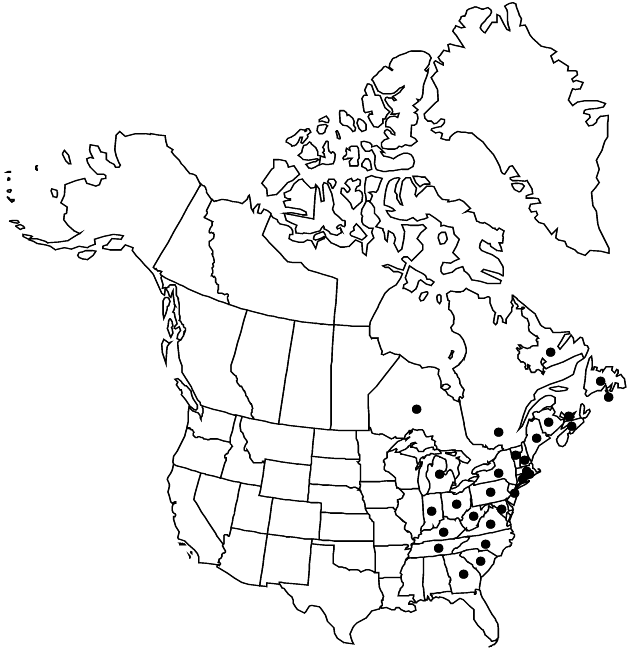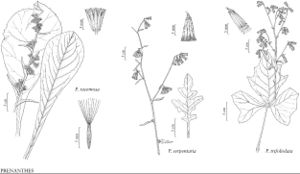Prenanthes trifoliolata
Contr. Bot. Vermont 8: 89. 1900.
Plants 10–150 cm; taproots thick, with lateral roots. Stems erect, green or sometimes mottled purple, usually glabrous, sometimes tomentulose distally. Leaves: proximal usually present at flowering; petiolate (petioles winged, 1–25 cm); blades deltate to ovate, 3–12 × 1–15 cm, thin, bases cordate to rounded, margins palmately 3 (–5) -lobed to divided (then leaves compound), lobes and sinuses usually angular (not rounded), lobes short and lanceolate, ultimate margins irregularly serrate, faces glabrous or ciliate along abaxial veins and margins; distal reduced, palmately lobed or entire. Heads (2–7, nodding, in irregular clusters) in racemiform or paniculiform arrays. Involucres narrowly campanulate (bases attenuate to bracteate peduncles), 10–13 × 4–5 mm. Calyculi of 5–7, green to dark green or blackish, triangular bractlets 1–3 mm, glabrous. Phyllaries 7–10, green to dark green or blackish proximally, lanceolate to elliptic, 10–11 mm, margins scarious, sometimes ciliate, faces glabrous. Florets 8–13; corollas pale-yellow, 9–15 mm. Cypselae tan to brown, subcylindric, subterete to angled, 4–5 mm, distinctly 8–11-ribbed; pappi pale-yellow, 7–9 mm. 2n = 16.
Phenology: Flowering Aug–Oct.
Habitat: Moist oak-hickory woods, swampy thickets, sandy areas, cliffs, sometimes saline habitats
Elevation: 0–1400 m
Distribution

St. Pierre and Miquelon, N.B., Nfld. and Labr., N.S., Ont., P.E.I., Que., Conn., Ga., Ind., Ky., Maine, Md., Mass., Mich., N.H., N.J., N.Y., N.C., Ohio, Pa., R.I., S.C., Tenn., Vt., Va., W.Va.
Discussion
Prenanthes trifoliolata is recognized by its relatively large, palmately 3–5-lobed leaves with angular lobes and sinuses, basally attenuate involucres, dark green and glabrous calyculi and phyllaries, and pale yellow corollas. Dwarf plants with deeply parted leaves found in alpine areas of northern New England and Canada have been recognized as P. nana or P. trifoliolata var. nana. This form is probably no more than a phenotypic adaptation to harsh environments. In at least some localities, it intergrades with more typical P. trifoliolata at lower elevations.
Hybrids between Prenanthes trifoliolata and P. racemosa, known as P. ×mainensis A. Gray, have been found in Maine, New Brunswick, Nova Scotia, and southern Quebec, usually where the two parents come together in cliff or saline habitats. The leaves of the hybrids are intermediate between 3-lobed and spatulate, the distal are sessile, the heads are nodding, and the phyllaries are glabrous, as in the P. trifoliolata parent.
Selected References
None.
Lower Taxa
No values specified."fine" is not a number.
